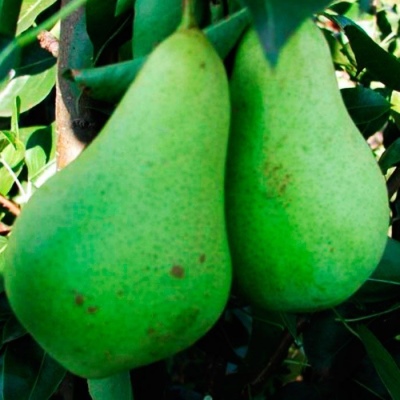
- Authors: S.P. Yakovlev, A.P. Gribanovsky, N.I. Saveliev, V.V. Chivilev (State Scientific Institution VNIIG and SPR named after I.V. Michurin)
- Appeared when crossing: Daughter of Dawn x Late MOSVIR
- Year of approval: 2002
- Fruit weight, g: 130
- Ripening terms: winter
- Fruit picking time: in the second decade of September
- Growth type: medium height
- Yield: high
- Crown: narrow pyramidal, medium density, compact
- Escapes: medium, straight, yellowish, naked
Pear Pervomayskaya, bred in the early 2000s, is already a fairly well-known winter variety and is actively grown in various regions of Russia. It has many positive characteristics, ranging from excellent frost resistance and high yields to excellent fruit taste.
Breeding history
The work on the new fruit tree was carried out by the breeders of the State Scientific Institution VNIIG and the SPR them. I. V. Michurin. The authors of the culture were Yakovlev S.P., Gribanovsky A.P., Savelyev N.I. and Chivilev V.V. Scientists crossed the pear varieties Daughter of Zarya and Pozdnyaya MOSVIR, as a result, the Pervomayskaya pear appeared, which has been listed in the State Register since 2002 and zoned for the Central Black Earth Region. In fact, the plant is successfully grown in other regions of the Russian Federation.
Description of the variety
Pear Pervomayskaya is a medium-sized tree that can reach 6-7 meters in height. The pyramidal crown is narrow, its density is medium. The shoots on the tree are straight, painted in a yellowish tone, the buds are conical. A distinctive feature of the variety is that it bears fruit on all branches. The leaves are round in shape and dark green in color, their surface is smooth.
Fruit characteristics
The fruits that ripen on Pervomayskaya have a standard pear-shaped shape (they are narrower at the base, with an extension at the other end). The size of each pear is 10 cm, the average weight is 130 g. The peel of the fruit is green-yellow and smooth, has a waxy bloom on the surface. If either side of the pear has been exposed to full sun, a slight pink blush may appear. The flesh of the pear is creamy.
Taste qualities
The pulp that is directly under the skin of the pear is usually juicy, medium-dense, semi-oily. The pear has a sour-sweet taste, with a strong aroma slightly reminiscent of peach or pineapple. Bitter notes are completely absent in the taste. Tasting score - 4.2 points out of five. Ripe fruits have a universal purpose. They can be eaten fresh, cooked, canned, made salads, used for baby food.
Ripening and fruiting
The culture belongs to the winter in terms of ripening. Pervomayskaya pear begins to bear fruit rather late, the first harvest can be expected at 5 or 6 years after planting the seedlings.

Yield
From 10-year-old trees of Pervomayskaya pears, from 40 to 60 kg of fruits are obtained. On an industrial scale, the yield is high - 163 c / ha.
Growing regions
The culture is zoned for cultivation in the Central Black Earth Region, namely: in the Voronezh, Belgorod, Kursk, Tambov, Oryol, Lipetsk regions.
Self-fertility and the need for pollinators
The variety is self-fertile, and in principle there is no need for additional pollinating varieties. But all experienced gardeners know: if you plant other varieties nearby, the crop yield will increase. In this case, you can plant varieties of pears Dessert or Yakimovskaya.
Landing
In the middle lane, a Pervomayskaya pear seedling can be planted already in mid-March.Autumn planting is allowed only in the southern regions. 2-year-old seedlings take root best of all, they have a higher resistance to changes in weather conditions, as well as to various diseases.
The diameter of the planting pit is usually 70 cm, the depth is 45 cm.The planting process includes several steps:
- place the tree in the center of the hole;
- install a support peg;
- cover the roots with soil;
- we compact the earth in the near-trunk circle;
- water abundantly.


Growing and care
The normal development of the Pervomayskaya varietal pear, as well as a high-quality harvest, can be achieved by performing the basic care measures. This is plentiful, as well as timely watering of the tree, the introduction of the optimal amount of nutrients, loosening of the soil in the near-trunk circle, the obligatory seasonal formation of the crown.



Disease and pest resistance
The fruit tree in question is highly resistant to ailments such as scab and fruit rot. Resistance to bacteriosis, which gardeners and farmers have to fight, is not very well developed.

Like any other fruit trees, the pear needs protection from various diseases and pests. When planting a pear on your site, you need to know in advance what diseases you should beware of. To successfully carry out the struggle, it is necessary first to correctly identify the cause of the problem. It is important to distinguish signs of disease from manifestations of the presence of insects, mites, caterpillars and other types of pests.
Resistance to soil and climatic conditions
Pear variety Pervomayskaya is recommended for cultivation in central Russia. The main reason for this is the good indicators of frost resistance of trees: the culture can withstand frosts down to -20-25 degrees.





































































